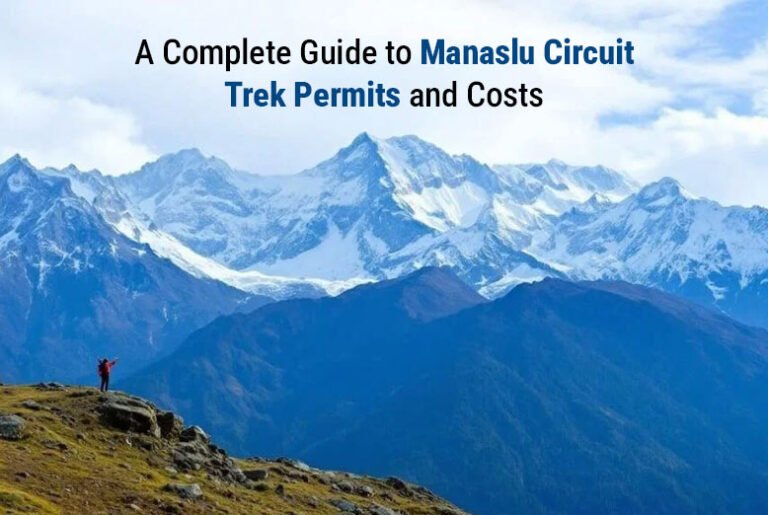The Manaslu Circuit Trek is one of Nepal’s most spectacular high-altitude journeys. Circling the eighth-highest mountain in the world (8,163 m), it offers rugged landscapes, ancient Tibetan culture, and a raw trekking experience. But unlike Everest or Annapurna, Manaslu lies within a restricted region, which means trekkers must navigate Nepal’s permit system carefully before setting foot on the trail.
This guide explains everything you need to know about permits and costs for the Manaslu Circuit Trek, from application procedures to seasonal pricing and practical considerations. By the end, you’ll know exactly what paperwork you need, how much to budget, and how to stay compliant with Nepalese regulations.
Why Are Permits Required for the Manaslu Circuit Trek?
The Manaslu region is classified as a restricted area by the Government of Nepal due to its proximity to the Tibetan (China) border and its cultural sensitivity. Permits serve two main purposes:
- Security and regulation: To monitor foreign presence in sensitive border zones.
- Conservation and sustainability: To fund environmental protection, trail maintenance, and community development.
Unlike popular routes like Everest Base Camp, you cannot simply buy a TIMS card and trek independently here—permits and a registered guide are mandatory.
Mandatory Permits for the Manaslu Circuit Trek
Trekkers need three main permits for the standard Manaslu Circuit:
- Manaslu Restricted Area Permit (RAP)
- Manaslu Conservation Area Permit (MCAP)
- Annapurna Conservation Area Permit (ACAP) – required if exiting via Thorong La or Dharapani.
Let’s break these down in details.
1. Manaslu Restricted Area Permit (RAP)
The RAP is the most important permit for the trek. It covers the restricted section of the trail from Jagat to Samagaun.
- Cost:
- September to November (peak season): USD 100 per person for the first 7 days, plus USD 15 per day thereafter.
- December to August (off-season): USD 75 per person for the first 7 days, plus USD 10 per day thereafter.
- September to November (peak season): USD 100 per person for the first 7 days, plus USD 15 per day thereafter.
- Duration: The permit is date-specific. You must provide an exact itinerary.
- Nationality rules: Costs are the same for all nationalities.
- Group requirement: Minimum two trekkers in a group, accompanied by a registered trekking guide. Solo permits are not issued.
2. Manaslu Conservation Area Permit (MCAP)
Managed by the National Trust for Nature Conservation (NTNC), the MCAP ensures conservation and trail upkeep.
- Cost:
- NPR 3,000 (approx. USD 23) per person for foreigners.
- NPR 1,000 (approx. USD 8) for SAARC nationals.
- Free for Nepali citizens.
- NPR 3,000 (approx. USD 23) per person for foreigners.
- Duration: Valid for the entire trek; no daily charges.
3. Annapurna Conservation Area Permit (ACAP)
The Manaslu Circuit typically ends at Dharapani, which falls within the Annapurna region. If you exit here or continue to Annapurna Circuit, ACAP is compulsory.
- Cost:
- NPR 3,000 (approx. USD 23) per person for foreigners.
- NPR 1,000 (approx. USD 8) for SAARC nationals.
- NPR 3,000 (approx. USD 23) per person for foreigners.
- Duration: Valid until you leave the conservation area.
Permit Application Process
You cannot apply for Manaslu permits independently. Here’s how it works:
- Book through a registered trekking agency in Nepal
- Only licensed local operators can issue RAPs.
- International agencies usually partner with Nepali operators.
- Only licensed local operators can issue RAPs.
- Provide required documents
- Valid passport (with 6+ months validity)
- Valid Nepal visa
- Four passport-sized photos
- Itinerary and entry/exit points
- Valid passport (with 6+ months validity)
- Allow processing time
- RAP processing usually takes 1 working day.
- Conservation permits (MCAP & ACAP) can be obtained instantly.
- RAP processing usually takes 1 working day.
Mandatory Guide Requirement
- Trekking solo in Manaslu is not allowed.
- A registered guide is compulsory.
- Agencies provide licensed guides, whose details are linked to your RAP application.
Why?
- For security in border areas.
- To ensure safety on remote, high-altitude terrain.
- To help with logistics, communication, and emergencies.
Additional Permits for Side Trips
If you extend your trek, you may need extra permits:
- Tsum Valley: Requires an additional Restricted Area Permit.
- Cost: USD 40/week (Sept–Nov), USD 30/week (Dec–Aug).
- Cost: USD 40/week (Sept–Nov), USD 30/week (Dec–Aug).
- Nar–Phu Valley or Upper Mustang: Additional RAPs apply if connected.
Always check with your trekking agency for combined routes.
Recent Changes and Updates (2025)
- Solo trekking ban reinforced – RAP applications require at least two trekkers.
- Digital permit records introduced – agencies now file online with Department of Immigration.
- Fixed exchange rates – Permit fees are charged in USD; you can pay in NPR at government exchange rates.
- Insurance checks – Some agencies require proof of travel insurance with helicopter evacuation coverage before processing RAPs.
How to Pay for Permits
- Payment is usually made via your trekking agency.
- Agencies accept USD, NPR, or card payments.
- Official fees go directly to Nepal Immigration and NTNC; your invoice should list permit charges separately from guide/agency service costs.
Budgeting Beyond Permits
When planning your trek, consider:
- Guide and porter costs:
- Guide: USD 25–35/day (including food, accommodation, insurance).
- Porter: USD 20–25/day.
- Guide: USD 25–35/day (including food, accommodation, insurance).
- Accommodation & meals: USD 20–30/day on the trek.
- Transportation:
- Jeep from Kathmandu to Soti Khola: USD 150–200 (private) or USD 15–20 (public).
- Jeep from Kathmandu to Soti Khola: USD 150–200 (private) or USD 15–20 (public).
- Insurance: USD 100–200 for 2–3 weeks, must cover high-altitude trekking (up to 5,160 m) and helicopter evacuation.
Practical Considerations for Trekkers
- Apply in Kathmandu – All permits must be issued before departure; checkpoints strictly enforce compliance.
- Carry multiple copies – Keep photocopies of permits and passport handy at police and army checkpoints.
- Be precise with dates – RAP validity is date-specific; overstaying can result in fines or legal complications.
- Currency tips – Pay in USD or NPR; cash is faster than cards due to network issues.
- Emergency contacts – Note your agency’s Kathmandu office number; they can coordinate rescues.
Step-by-Step Permit Checklist
- Choose a licensed trekking agency.
- Provide passport, visa, itinerary, and photos.
- Pay permit fees through the agency.
- Receive RAP, MCAP, and ACAP permits.
- Confirm guide details are registered with Immigration.
- Carry permits throughout the trek and show at checkpoints.
Final Thoughts
The Manaslu Circuit Trek is one of Nepal’s last truly wild Himalayan circuits, but its restricted status means careful preparation. With the right permits, guide, and insurance in place, you can focus on enjoying soaring peaks, ancient monasteries, and one of the most rewarding adventures in the Himalayas.
While the permit process may seem complex, trekking agencies streamline it so you can trek worry-free. Just budget for the costs, bring the right documents, and follow Nepal’s regulations.
Also Read: Best 5 PCB Design Companies in the USA That Are Redefining Electronics



